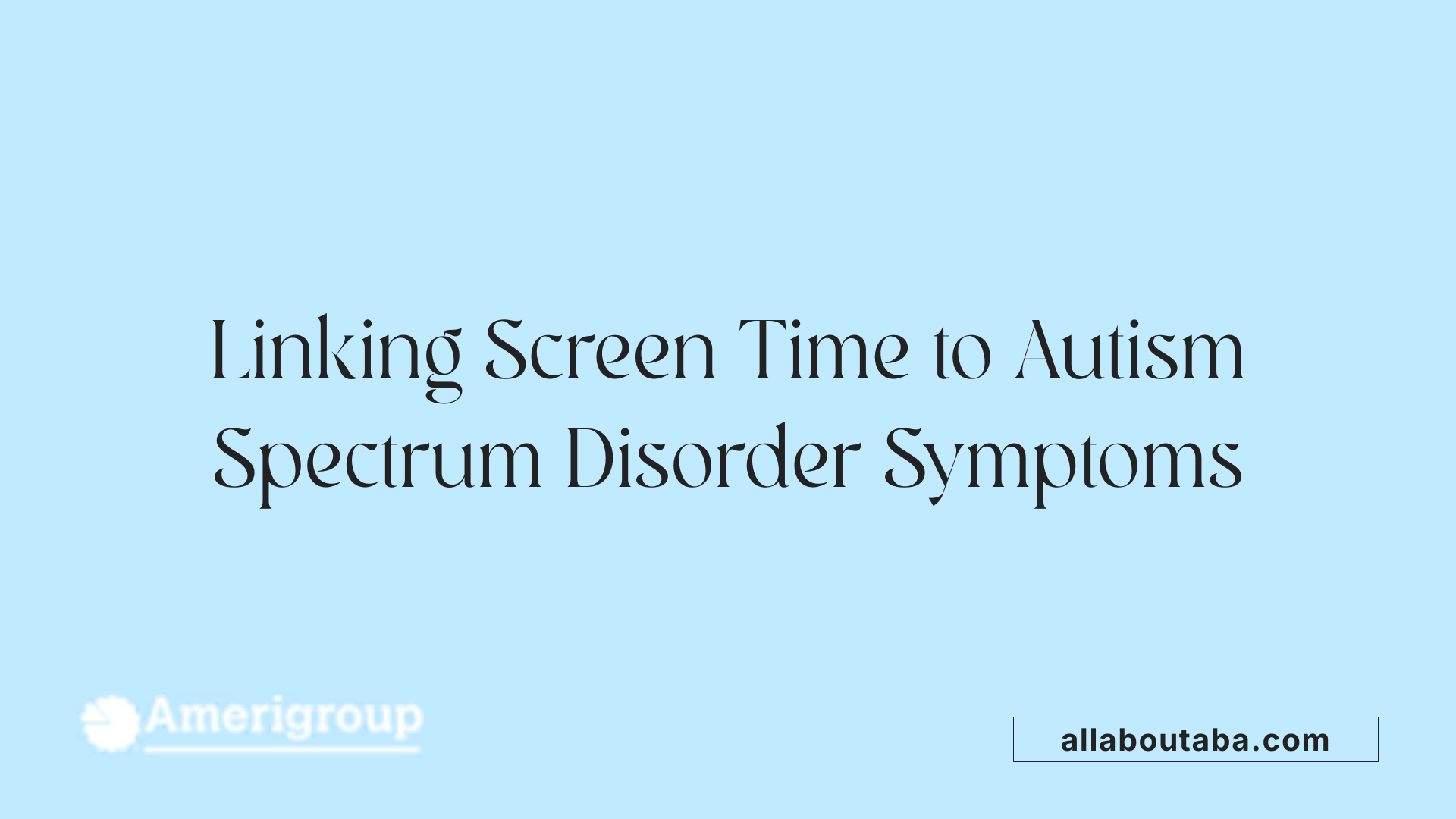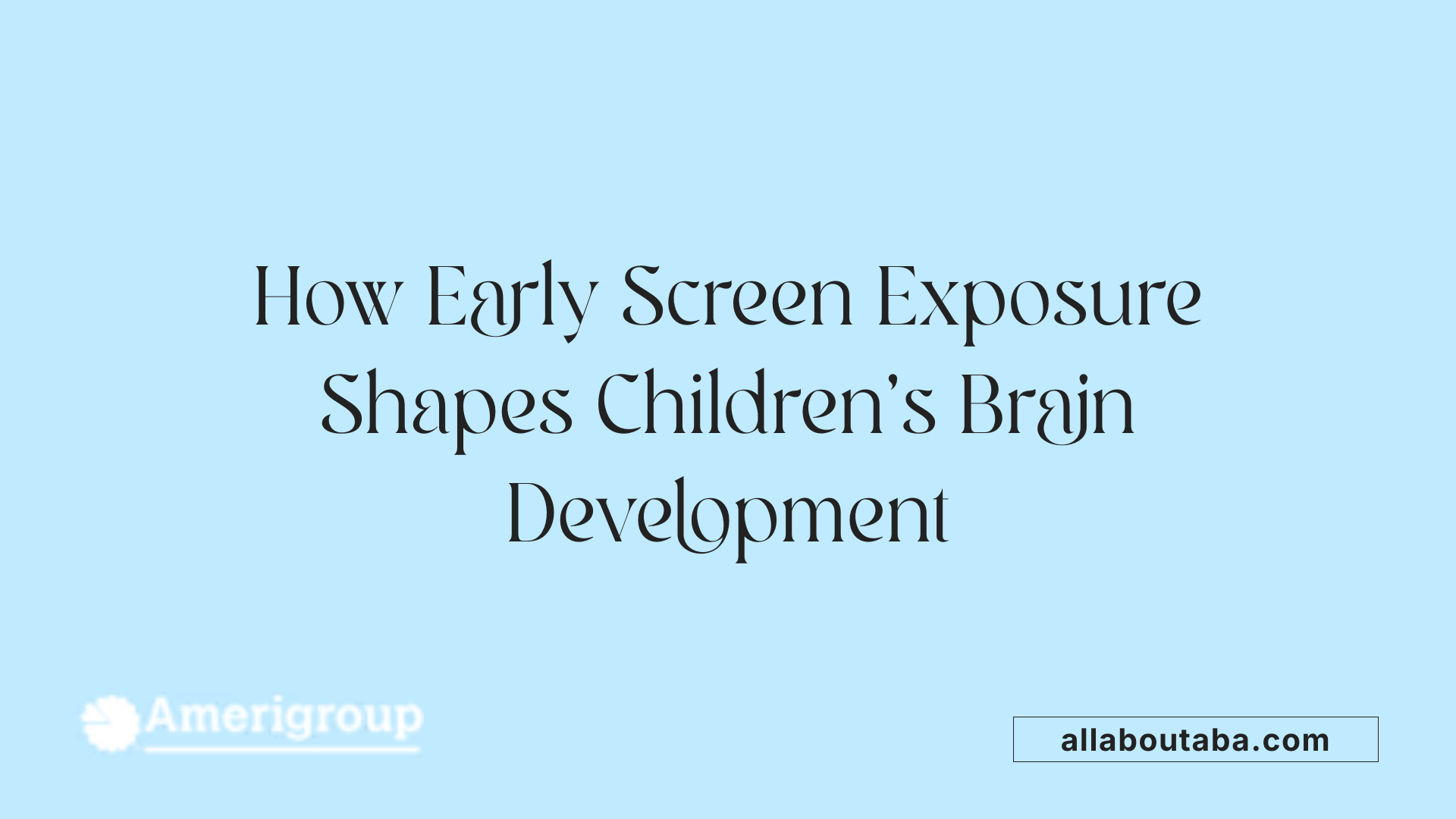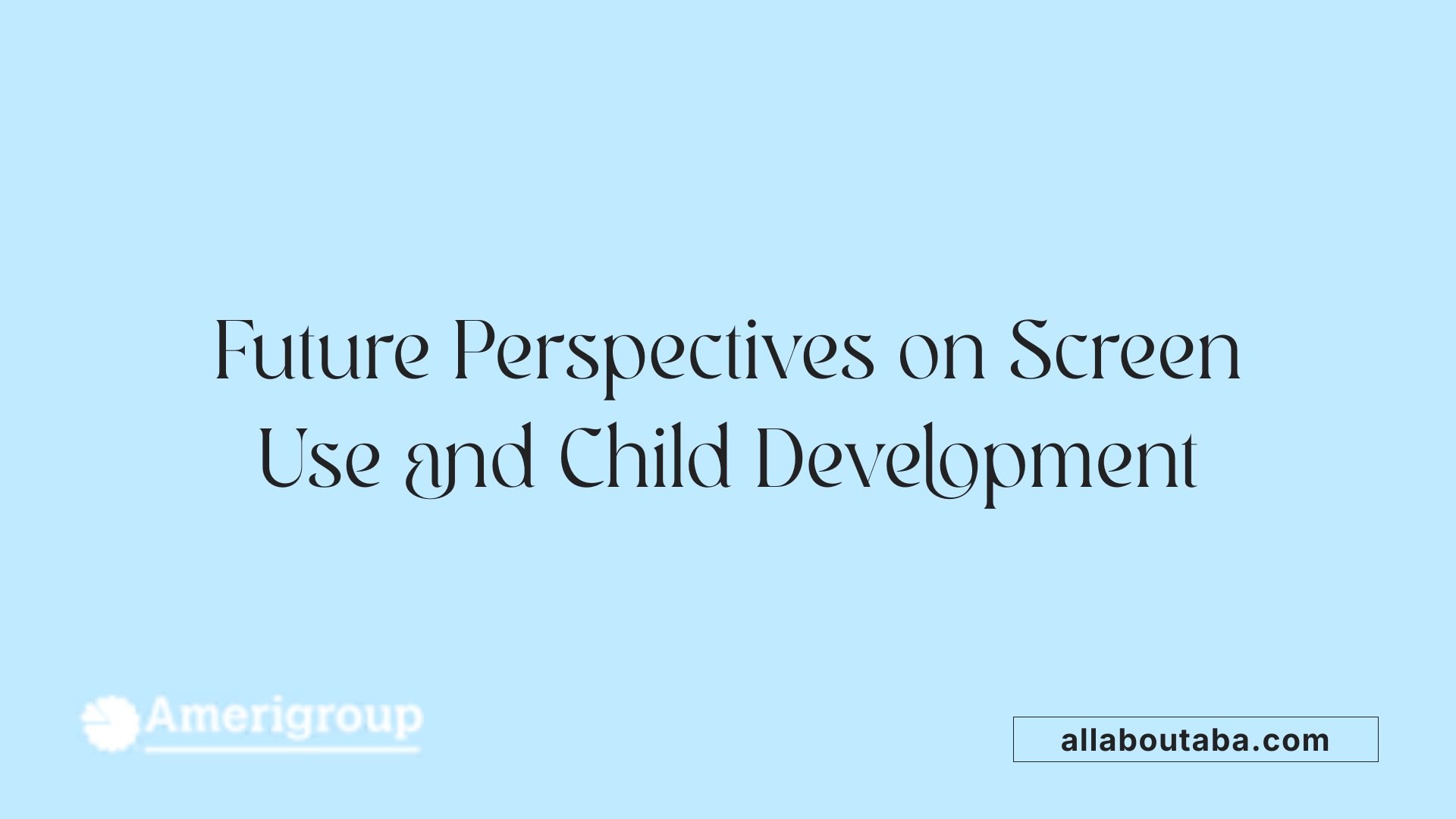Understanding the Emerging Links
In recent years, scientific research has increasingly explored the relationship between screen time and autism spectrum disorder (ASD). While autism is primarily driven by genetic and biological factors, early exposure to electronic media appears to influence neurodevelopmental trajectories and can exacerbate or mimic certain autistic behaviors. This article reviews current studies, neurological mechanisms, behavioral outcomes, clinical findings, and expert opinions to shed light on how screen exposure during sensitive developmental periods may impact autism development.
Association Between Early Screen Exposure and Autism Symptoms

Impact of screen time on early childhood development
Excessive screen time during the formative years can significantly influence a child's neurodevelopment. Research has shown that children exposed to screens for more than two hours daily exhibit increased signs of communication difficulties and autism-like behaviors. When screen time occurs very early, especially before the age of two, it can interfere with critical developmental milestones such as language acquisition, social engagement, and emotional regulation. The first year of life is particularly sensitive, as the brain undergoes rapid growth and is highly plastic, meaning that habits formed during this period can have lasting effects.
Screen exposure, particularly without adult guidance, has been linked to disruptions in sleep patterns, reduced attention spans, and altered brain structure. For instance, studies have identified changes in brain chemistry, including lower melatonin production and neurotransmitter imbalances, which may contribute to behavioral issues similar to those seen in autism spectrum disorder (ASD).
Screen time's correlation with autism spectrum disorder symptoms
Many children with ASD tend to spend more time engaging with screens than their neurotypical peers. Studies report that children exceeding three hours of daily screen time are at heightened risk of displaying autism-related symptoms. Features such as speech delay, limited eye contact, and repetitive behaviors often coincide with high digital media use.
Furthermore, research using parent-report screening tools like the Modified Checklist for Autism in Toddlers (M-CHAT-R) has identified a positive association between extensive screen exposure and elevated ASD risk. While these tools are not diagnostic, they help flag children who may need further assessment. Notably, intervention studies that reduce screen time and replace it with social and physical activities have shown promising improvements in language skills, social behaviors, and a decrease in autism severity.
Research using screening tools like M-CHAT-R
The M-CHAT-R is commonly used to screen for early signs of autism in young children. A number of studies utilizing this tool reveal that children with higher screen time are more likely to score above the screening threshold, indicating potential ASD. For instance, a study in Japan found that screen time at age one predicted parent-reported ASD diagnosis at age three. This correlation suggests that early exposure may influence or reflect emerging developmental differences.
However, it's essential to interpret these results cautiously, as screening tools are not definitive diagnoses. Many children who screen positive may not have autism but could exhibit other developmental delays or behavioral challenges. Still, the consistent pattern across diverse studies highlights the importance of moderating screen exposure during early childhood.
| Aspect | Findings | Additional Notes |
|---|---|---|
| Screen time duration | >2-3 hours daily linked to ASD symptoms | Especially before age 2 |
| Age at first exposure | <2 years associated with higher ASD risk | Critical early window |
| Benefits of reduction | Decreased symptoms and parental stress | Effective when replaced with social activities |
| Screening tools used | M-CHAT-R, parent reports | Not diagnostic but indicative |
| Brain development impact | Altered neurochemical levels, less organized brain matter | Neuroplasticity offers intervention opportunities |
Overall, the accumulating evidence underscores the importance of limiting screen time during early childhood to promote healthier neurodevelopment and reduce the risk or severity of autism spectrum disorder symptoms.
Neurological Impact of Early Electronic Screen Exposure

How does early electronic screen exposure affect neurological development in children?
Early exposure to electronic screens can have profound effects on a child's brain development. During early childhood, the brain is especially plastic, meaning it is highly adaptable but also vulnerable to environmental influences like screen media. Excessive screen time during this critical period can alter the development of brain regions responsible for language, social interaction, attention regulation, and emotional control.
Research indicates that children with high screen exposure often experience delays in language acquisition and cognitive skills. Neuroimaging studies suggest that such children may show decreased cortical thickness and less organized neural connectivity, which can impair learning and emotional understanding. Moreover, early screen exposure interferes with typical myelination processes, leading to weaker communication pathways among brain regions.
Sleep disturbances caused by screen use—such as disrupted melatonin production and altered circadian rhythms—further hinder brain maturation. Poor sleep quality has been linked to increased inflammation and neurochemical imbalances, adversely affecting neural growth.
Structural brain changes are also documented, with findings pointing to reduced grey and white matter volumes in children with excessive media use. These alterations may correlate with behavioral problems like hyperactivity, poor impulse control, and social difficulties. Notably, exposure to fast-paced or violent content can intensify these effects, fostering antisocial behaviors and emotional dysregulation.
While educational content under supervised conditions might support development, unregulated or passive screen time tends to be detrimental. Promoting interactive activities such as reading, play, or outdoor exploration helps nurture healthy neural development.
In summary, managing screen exposure and content quality is vital for safeguarding neurological growth in early childhood, ensuring optimal brain architecture and functioning vital for lifelong cognitive and social well-being.
Behavioral and Language Outcomes in Children at Risk for Autism
What are the behavioral and language development outcomes associated with screen time in children at risk for autism?
Excessive screen time, especially more than three hours daily, has been linked to increased social communication difficulties and autism-like symptoms in children at risk for autism spectrum disorder (ASD). Research shows that higher screen exposure correlates with delays in language acquisition, reduced social engagement, and difficulties with behavioral regulation.
Children under 12 years old seem particularly vulnerable, with studies indicating that early and prolonged screen exposure can impede typical neurodevelopment paths. For example, children who spend more time on screens often demonstrate speech delays, poor eye contact, and reduced interest in social interactions—all behaviors associated with autism.
When parents and caregivers actively intervene by reducing screen time and encouraging social activities, many children experience notable improvements. These can include better language skills, increased social responsiveness, and enhanced behavioral regulation.
Children with autism are observed to spend more time on screens than their neurotypical peers, which may exacerbate underlying challenges. Conversely, interventions that decrease screen exposure and promote parent-child interactions have shown positive outcomes, such as reduced severity of core ASD symptoms.
In summary, moderation in screen use combined with active social engagement is vital for supporting healthy behavioral and language development. Early social experiences and parental involvement serve as protective factors, helping at-risk children reach developmental milestones and reduce the potential negative impact of screen overexposure.
Scientific Evidence and Research Findings

What does current scientific research say about the impact of screen time on autism symptoms and neurodevelopment?
Recent studies highlight a noticeable association between increased screen time in early childhood and the manifestation of autism-like behaviors. Multiple observational research efforts and meta-analyses have observed that children who are exposed to screens for more than two to three hours daily tend to exhibit higher levels of communication difficulties, language delays, and behaviors resembling autism.
For example, one systematic review of over 46 studies involving more than 560,000 participants found a small but significant positive link between general screen use and ASD symptoms. However, after adjusting for publication bias, this connection was less definitive, emphasizing the need for cautious interpretation.
Research focusing on early childhood indicates that screen exposure before age 2 is particularly concerning. Studies from Japan and Australia demonstrate that high screen time at age 1 can predict autism diagnosis or development of autism traits by age 3 or 12. These findings suggest that early media overexposure might influence neurodevelopment during critical periods.
Brain imaging studies further reveal that children with consistent high screen exposure often show differences in brain structure, such as less organized white and grey matter. Neurochemical alterations, like reduced melatonin and neurotransmitter imbalances, have also been documented, implying potential impacts on sleep, mood regulation, and overall brain development.
Despite these associations, causality remains unconfirmed. Several studies point out that children with autism traits may simply be more drawn to screens, or that other factors—such as socioeconomic status—confound the relationship. For example, a large longitudinal study found initial links between higher screen time at age 2 and ASD risk at age 12, but this association diminished when socioeconomic variables were accounted for.
Nevertheless, the consensus among health authorities, including the American Academy of Pediatrics, emphasizes limiting screen time during infancy and early childhood to promote better language, social, and emotional development. Encouraging social engagement and interactive activities are recommended as protective strategies.
In summary, current evidence indicates a correlation between excessive early screen exposure and increased autism symptoms and neurodevelopmental concerns, but more robust, causal research is needed. Meanwhile, moderation and developmental-focused activities remain essential in nurturing healthy growth.
Expert Opinions and Current Debate

What are the expert opinions and the latest research findings on the implications of screen time for autism development?
Recent studies and expert analyses indicate that there is a noticeable association between prolonged screen time during early childhood and increased autism-like behaviors. For example, children who spend more than three hours daily on screens often show higher scores on screening tools like M-CHAT, which suggests more pronounced autism-like symptoms.
However, experts stress that this correlation does not prove causation. Dr. Ferguson and other researchers emphasize that the small effect sizes observed in some studies mean that increased screen time alone is unlikely to cause autism directly. Instead, these findings may reflect developmental variations or environmental influences, such as reduced social interactions or parent-child engagement.
Research also suggests that excessive screen exposure during early years—particularly before age 2—may disrupt neurodevelopment, affecting sleep, language acquisition, and social behaviors. These disruptions could contribute to characteristics observed in autism spectrum disorder (ASD), like speech delay and attention issues.
On the intervention front, some evidence shows that replacing screen time with interactive, socially engaging activities can lead to symptom improvements. For instance, targeted reductions in screen use and increased parental involvement have been associated with decreases in autism symptoms and better developmental outcomes.
Overall, the prevailing consensus among clinicians and researchers is that moderation is essential. Limiting screen time, especially during critical early years, combined with fostering real-world social and play experiences, holds promise for supporting healthy development. Experts advocate a balanced approach, recognizing that while screens are a part of modern life, ensuring adequate social interaction and activity diversity is vital for neurodevelopment, particularly in vulnerable or at-risk children.
Interventions and Recommendations for Parents and Caregivers
How can reducing screen time influence autism symptoms and development?
Limiting screen exposure and replacing digital media with interactive, social activities can dramatically impact a child's developmental progress. Research shows that decreasing screen time from high levels—such as over five hours daily—to just a few minutes can lead to notable improvements in autism-like behaviors.
Children who engage less with screens and more with face-to-face interactions demonstrate better language skills, improved social engagement, and fewer repetitive behaviors. For example, in case reports, children with ASD who reduced their screen time significantly experienced improvements in verbal communication and social responsiveness.
Parent training programs are essential components of these interventions. Training helps parents implement consistent boundaries for screen use, select suitable content, and encourage play and interaction. Such guidance can foster an environment that promotes neuroplasticity—the brain’s ability to adapt—especially vital during early childhood.
Reducing digital media use also impacts neurochemical and brain structure development. Excessive screen time has been associated with less organized white and grey matter, altered neurotransmitter levels, and disrupted sleep patterns—all factors that can worsen autism symptoms.
Beyond individual benefits, decreasing screen exposure allows children more opportunities for physical activity, outdoor play, and social interaction. These elements are critical for comprehensive development, supporting cognitive, emotional, and social growth.
To maximize positive outcomes, caregivers should create structured routines that limit screen time, choose engaging offline activities, and foster connections through shared experiences. Such practices can reduce the severity of autism symptoms and promote healthier development during critical early years.
Promoting social and physical activities
Parents can encourage outdoor play, reading, arts and crafts, and group activities that promote social skills. Replacing screen time with these activities helps develop language, sensory processing, and social cognition.
Parental involvement and training
Educational programs equip parents with practical strategies for managing media use, improving communication, and supporting behavioral transitions. Active parental involvement has been shown to reduce autism symptoms and improve adaptive behaviors.
Impacts of digital media reduction
Evidence underscores that cutting back on screen time not only benefits those with ASD but also supports overall healthy growth for all children. It can mitigate risks of sleep disturbances, attention issues, and behavioral problems, fostering a balanced developmental environment.
Conclusion and Future Directions

What does current scientific research say about the impact of screen time on autism symptoms and neurodevelopment?
Recent studies consistently show that increased screen exposure in early childhood is associated with autism-like behaviors and developmental delays. Research indicates that children exposed to screens for more than two hours daily, especially before age 2, tend to display more symptoms related to autism spectrum disorder (ASD), including speech delays, attention issues, and social difficulties.
Brain imaging studies also reveal structural differences, such as less organized gray matter and white matter in children with high screen time. Moreover, neurochemical changes, like reduced melatonin and altered neurotransmitter levels, suggest that excessive screen use during critical neurodevelopmental periods can influence brain maturation.
While no research definitively proves that screen time causes autism, accumulating evidence implies a potential contributory role or a marker of underlying developmental vulnerabilities. Guidelines from health authorities emphasize limiting screen exposure for young children, promoting social interaction and active play instead.
Limitations of current research
Most existing studies on screen time and autism are observational and correlational, limiting conclusions about causality. Many rely on parental reports and screening tools like M-CHAT, which are not diagnostic, and there is potential bias from confounding factors such as socioeconomic status.
Additionally, some studies show mixed results, especially regarding early exposure during the first year of life, with evidence affected by measurement variability and differences in cultural contexts.
Research gaps and needs
Further longitudinal, controlled experiments are necessary to clarify whether excessive screen time directly influences neurodevelopment leading to ASD. Future research should also explore the biological mechanisms, including neurochemical and structural brain changes, and identify critical windows for intervention.
It is important to examine how specific types of screen activities—like social media versus passive video watching—differ in their impact. Investigating how familial and environmental factors modify these effects is equally crucial.
Implications for policy and practice
Based on current evidence, policymakers should reinforce guidelines limiting screen time for children under two, encouraging more interactive and socially engaging activities.
Parents and caregivers are advised to reduce passive screen exposure and substitute with play, reading, and social interactions. Early intervention programs focusing on social communication skills and parent training to manage media use are effective strategies.
In conclusion, while additional research is needed, existing studies support cautious use of screens during early childhood to foster healthier neurodevelopment and potentially reduce the risk or severity of autism symptoms.
Towards Better Understanding and Practice
Although the relationship between screen time and autism is complex and not fully causal, current evidence underscores the importance of moderating screen exposure during critical early developmental periods. Encouraging active social engagement, reducing passive media consumption, and supporting families with targeted interventions can potentially mitigate the risk factors associated with autism-like behaviors and promote healthier neurodevelopment. Ongoing research is essential to further explore causality, biological mechanisms, and effective preventive strategies.
References
- Early Screen-Time Exposure and Its Association With Risk ...
- Early Childhood Screen Time, Brain Development, and ...
- Screen Time Before 2 Years of Age and Risk of Autism at ...
- Screen Time and Social Engagement in Early Childhood ...
- Early electronic screen exposure and autistic-like symptoms
- Screen Time and Autism Spectrum Disorder: A Systematic ...
- Changes in autism symptoms associated with screen ...
- Autism and Screen Time: A Must-Know Connection for ...
- Autism and screen time could be related, study shows







